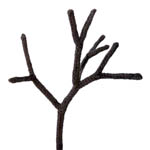Alder Leaf (F3)

The European Alder has a rounded leaf. I don't actually have anything else to say about it. I'm now looking up Alder facts online. Apparently the wood is traditionally used to make clogs...
A printable version of this pattern is available.
You will need:
- green yarn (double knit)
- covered thin gauge wire (e.g. garden twist tie)
- 2 x double ended knitting needles (3mm)
- tapestry needle
- scissors
Pattern:
(A list of standard abbreviations is available.)
Leaf:
Cast on 5 stitches and continue in the flat.
- Row 1: kfb x 4, k1 (9)
- Row 2: pfkb, p2, [k1, p1] x 2, pfkb, p1 (11)
- Row 3: k1, p1, k2, pfkb, kfb, p1, k2, p1, k1 (13)
- Row 4: p1, [k1, p2] x 2, p1, k1, p2, k1, p1 (13)
- Row 5: k1, p1, k2, p1, kfb x 2, k1, p1, k2, p1, k1 (15)
- Row 6: pfkb, [k1, p2] x 2, p3, k1, p2, kfb, p1 (17)
- Row 7: [k2, p1] x 2, k1, kfb x 2, [k2, p1] x 2, k2 (19)
- Row 8: [p2, k1] x 3, p1, k1, [p2, k1] x 2, p2 (19)
- Row 9: [k2, p1] x 2, k2, pfkb, kfb, [p1, k2] x 3 (21)
- Row 10: [p2, k1] x 3, p3, [k1, p2] x 3 (21)
- Row 11: [k2, p1] x 3, kfb x 2, k1, [p1, k2] x 3 (23)
- Row 12: p1, k2tog, [p2, k1] x 2, p5, [k1, p2] x 2, k2togtbl, p1 (21)
- Row 13: k1, [p1, k2] x 2, p1, k1, kfb x 2, [k2, p1] x 3, k1 (23)
- Row 14: p1, [k1, p2] x 3, k1, p1, [k1, p2] x 3, k1, p1 (23)
- Row 15: k1, [p1, k2] x 3, pfkb, kfb, [p1, k2] x 3, p1, k1 (25)
- Row 16: p1, p2tog, p1, [k1, p2] x 2, k1, p3, k1, [p2, k1] x 2, p1, p2togtbl, p1 (23)
- Row 17: k1, [k2, p1] x 3, kfb x 2, k1, [p1, k2] x 3, k1 (25)
- Row 18: p1, p2tog, [k1, p2] x 2, k1, p5, k1, [p2, k1] x 2, p2togtbl, p1 (23)
- Row 19: [k2, p1] x 3, k1, kfb x 2, [k2, p1] x 3, k2 (25)
- Row 20: p1, k2tog, [p2, k1] x 3, p1, [k1, p2] x 3, k2togtbl, p1 (23)
- Row 21: k1, k2tog, k1, [p1, k2] x 2, pfkb, kfb, [p1, k2] x 2, p1, k1, k2togtbl, k1 (23)
- Row 22: p1, p2tog, [k1, p2] x 3, p1, [k1, p2] x 2, k1, p2togtbl, p1 (21)
- Row 23: k1, p2togtbl, [k2, p1] x 2, kfb x 2, k1, [p1, k2] x 2, p2tog, k1 (21)
- Row 24: p1, p2tog, p1, [k1, p2] x 2, p1, [p2, k1] x 2, p1, p2togtbl, p1 (19)
- Row 25: k1, [k2tog, p1] x 2, k2tog x 2, k1, [p1, k2togtbl] x 2, k1 (13)
- Row 26: p2tog, k1, p1, k1, yfwd, sl1, p2tog, psso, k1, p1, k1, p2tog (9)
Cut yarn and pull through remaining stitches from stitch 1 (nearest the tail) to stitch 9 (furthest from the tail. Pull the stitches tight from stitch 9 back to stitch 1 so that you can pull the loose yarn through them and get a neat edge.
Veins/Stalk:
- Cast on 2 sts
- i-cord 3 rows.
- Working as for i-cord, kfb, k1 (3)
- i-cord 3 rows.
- Working as for i-cord, kfb, k2 (4)
- i-cord until the vein is same length as the leaf.
- Thread yarn through remaining sts.
Making Up:
For a neater top edge embroider a line of chain stitch across the gathered stitches.
Bend a piece of wire to half the length of the leaf, doubling the ends over for safety (see diagram).
Cover the wire stalk with the knitted vein. Attach the vein along the centre of the leaf. The vein should not quite reach all the way to the tip of the leaf. Sew in any remaining loose ends.
Look at the ODDknit patterns for twigs and horse chestnut leaves for ideas on joining multiple leaves together. Alternatively the wire can be left out completely if your leaf is going to be for fun rather than display.
Notes:
Needle/Yarn Size
As with most ODDknit patterns the yarn and needle sizes in the "you will need" section are just a guide. Feel free to improvise with whatever needles and yarn you have lying around – that's half the fun!
<<< See more Trees and Leaves
© 2013 All desgins and images are copyright of ODDknit. If you enjoy the content of this website, please consider buying me a coffee at the link below.









